
|
Jacket 5, October 1998
| # 5 Contents | Homepage |
|
|
david lehman |
the making of
|
the last avant-garde
|
|
|
the new york school of poets
|
|
|
THE STORY of the New York School of poets is a study in friendship, artistic collaboration, and the bliss of being alive and young at a moment of maximum creative ferment. It is also the story of the last authentic avant-garde movement that we have had in American poetry. You can read Paul Hoover’s review of this book in Jacket # 6. |
|
WHEN JOHN ASHBERY, Kenneth Koch, Frank O’Hara, and James Schuyler (pronounced “SKY-luh”) first lived in New York, the Korean War
was in progress and McCarthyism was the scourge of freethinking intellectuals. It was the era of
Levittown* and the “silent generation” when the original Guys and Dolls
was on Broadway, suburban flight was in progress, New York had three baseball teams and at least
one of them played in the World Series every year. |
|
|
In an age of
split-level conformism, the poets of the New York School put their trust in the idea of an artistic
vanguard that could sanction their deviations from the norm. The liberating effect of their writing
became increasingly evident in the passionate, experimental, taboo-breaking early 1960s, when the
nation’s youngest president was in office, men discarded their hats, women started using the
Pill, the acceleration in the speed of social change seemed to double overnight, and America
finally left the nineteenth century behind. |
|
The artists maintained “a belligerent attitude toward the world and a
genuine sympathy for each other.” They lived and worked “in an atmosphere of perpetual
collaboration.” The avant-garde “was a way of life, both dedicated and frivolous,”
generating tremendous excitement. Guillaume Apollinaire, a poet, was the “impresario of the
avant-garde,” the champion of Cubism and the man who gave Surrealism its name.
Apollinaire’s “magnetic presence” and his “expansive, volatile nature flowed
inexhaustibly on and left behind it poems and lyric texts which seemed to flower effortlessly out
of his enthusiasms.”; |

|
Substitute Frank O’Hara for Apollinaire and Abstract Expressionism for Cubism, and you get
an eerie fit. The poets of the New York School were as heterodox, as belligerent toward the
literary establishment and as loyal to each other, as their Parisian predecessors had been. The
1950s and early ’60s in New York were their banquet years. It is as though they translated the
avant-garde idiom of “perpetual collaboration” from the argot of turn-of-the-century
Paris to the rough-hewn vernacular of the American metropolis at mid-century.
|
|
WHILE THE FOUR core members of the New York School
did not set out to recruit disciples, never issuing public statements or devising a group program
in the manner of the French Surrealists, they had a close sense of community and an awareness that
their destinies as poets were intertwined. They shared much else besides, including the conviction
that they were heading for greatness. Witnesses to what Robert Motherwell called “the greatest
painting adventure of our time,” they strove for the same excitement in poetry, looking to the
painters as the agents of artistic change. “New York poets, except I suppose the color blind,
are affected most by the floods of paint in whose crashing surf we all scramble,” Schuyler
wrote in 1959, summing up a decade and more of unprecedented artistic turbulence. “In New York the art world is a painters’ world; writers and musicians are in the boat but they don’t
steer.”
|

left to right:
|
|
The poets took their lead from the Abstract Expressionists (also known as the Action Painters and
as the New York School of painting) in several key respects. From Jackson Pollock and Willem de
Kooning, they learned that it was okay for a poem to chronicle the history of its own making — that
the mind of the poet, rather than the world, could be the true subject of the poem — and that it
was possible for a poem to be (or to perform) a statement without making a statement. From the
painters, too, they understood that acceptance was not necessarily a blessing, nor rejection a
curse. “The literary establishment cared as much for our work as the Frick cared for Pollock
and de Kooning,” O’Hara wrote defiantly, pushing the analogy between poets and painters.
Like painting, writing was properly understood to be an activity, a present-tense process, and the
residue of that activity could not help referring to itself. All poetry was the product of a
collaboration with language. While mimesis, the imitation of nature, remained a goal of art, the
abstract painters had redefined the concept by enlarging the meaning of nature; “I am
nature,” Pollock said. This, too, was a liberty the poets could take. Like abstract paintings,
their poems originated not in a Platonic conception of their final form but in an engagement with
the medium of expression itself.
|
|
STILL, THE POETS meant to honor the great example
of Abstract Expressionism not only by absorbing its principles but also by veering from them as
their own development required. In this exact regard, they paralleled their closest friends among
the so-called Second Generation of New York School painters — Fairfield Porter, Jane Freilicher,
Nell Blaine, and Larry Rivers among them — who strove to learn from Pollock, de Kooning, and the
rest, without the slavish fidelity of epigones. The Second Generation painters veered by returning
to figuration at the very moment when the critic Clement Greenberg, the ayatollah of Abstract
Expressionism, declared that painting had to be abstract and “flat.” The poets veered in
an equally fundamental way. In place of the high seriousness that engulfed the Abstract
Expressionists, they opted for aesthetic pleasure. They were ironists, not ecelesiasts. They
favored wit, humor, and the advanced irony of the blague (that is, the insolent jest or
prank) in ways more suggestive of Jasper Johns and Robert Rauschenberg than of the New York School
painters after whom they were named. About everything, including the ideals and pretensions of the
avant-garde, the poets could be jubilantly irreverent, as when Frank O’Hara collaborated with
Larry Rivers on “How to Proceed in the Arts,” their satirical “study of the creative
act” (1961): “Youth wants to burn the museums. We are in them — now what? Better destroy the odors of the zoo. How can we paint the elephants and hippopotamuses? Embrace the Bourgeoisie. One hundred years of grinding our teeth have made us tired. How are we to fill the large empty canvas at the end of the large empty loft? You do have a loft, don’t you, man?”
|
|
THE POETS liked hoaxes and spoofs, parodies and strange juxtapositions, pseudotranslations and collages. On the ground that the rules of all verse
forms are at base arbitrary, they created ad hoc forms (requiring, say, an anagram or the name of a
river in every line) and unconventional self-assignments (“translate a poem from a language
you do not understand; do not use a glossary or dictionary”). They adapted the Cubist collage
and the Surrealist “exquisite corpse” (a one-line poem composed by a group of poets, each
of whom contributes a word without knowing what the others have written). Apollinaire’s café
poems, “Les Fenêtres” and “Lundi rue Christine,” taught them that a poem could
originate in snatches of overheard conversations. You could cull lines at random from books. Or you
could scramble the lines in an already written poem to produce a disjunctive jolt. Many works would
be improved if you simply deleted every second word. Poems didn’t have to make sense in a
conventional way; they could discover their sense as they went along. The logic of a dream or a
word game was as valid as that of empirical science as a means of arriving at poetic knowledge.
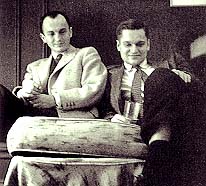
Frank O’Hara and John Ashbery, New York November 1953 Freely experimental and fiercely intellectual, the poets were at the same time resolutely anti-academic and anti-establishment even as they began to win acceptance in establishment circles. |
|
Some of their more radical productions neither looked like nor sounded like
poems. Since acceptance or rejection of these works was an indication neither of success or
failure, the poets looked to each other as ultimate arbiters. “John and Frank and I were
almost like a mutual admiration society,” Schuyler said. But they also competed fiercely, each
trying to outdo the other. “It’s wonderful,” Koch said many years later, “to
have three good friends that you think are geniuses.” The poets were “like the members of
a team, like the Yankees or the Minnesota Vikings,” Koch elaborated. “We inspired each
other, we envied each other, we emulated each other, we were very critical of each other, we
admired each other, we were almost entirely dependent on each other for support. Each had to be
better than the others but if one flopped we all did.” They were prolific. In addition to
their own work in several genres, they collaborated with painter pals on collages and lithographs
and comic strips. Collaborating with each other, they produced poems, plays, a novel, and four
issues of a literary magazine they called Locus Solus, the very model of an avant-garde
journal, which they named after a prose masterpiece by Raymond Roussel, the ultimate avant-garde
writer. The whole period was, in Koch’s phrase, “fizzy with collaboration.”
|
|
ALL THIS ACTIVITY was predicated on the idea that
poetry could be reinvented from top to toe. Everything was up for grabs. “It came to me
that all this time / There had been no real poetry and that it needed to be invented,”
Koch writes in “Days and Nights,” one of several of his poems that look back to the
seminal 1950s. The approved American poetry of the time was crusty with convention. “There was
no modern poetry in the sense that there was modern painting,” Ashbery asserted. The
avant-garde writer had the advantage of beginning with a clean slate (or the illusion of one). The
rejection of the acceptable poetry of the age made it possible to pursue a grander ambition:
“to write poetry that is better than poetry,” in Koch’s words. It is not that
Ashbery, Koch, O’Hara, and Schuyler were ignorant of poetic tradition. On the contrary, they
were voracious readers. But they recognized that tradition is a vast passing-away and renewal, and
they had enough respect for the past not to copy it lazily but to adapt, alter, and adjust the
tradition through the application of their individual talents. They understood, too, that a poem no
less than a picture could be “a hoard of destructions,” in Picasso’s phrase. And so
they favored avant-garde methods of composition that inverted the received order of things. The aim
was the liberation of the imagination, and any and all means to this end were valid.
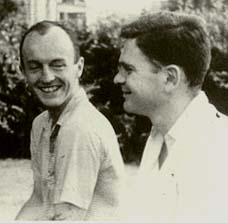
Detail: Frank O’Hara and James Schuyler, Southhampton, 1956. Photo copyright © John Button, 1956. Forty years after Pound and Eliot made the first modernist revolution in poetry, the New York poets were the first to extend that new frontier. |
|
They were intent on widening
the framework of American poetry; they wanted to be read not in the narrow context of the
Anglo-American poetry of mid-century but with reference to other arts, earlier periods, alternative
traditions. The poets were unusually responsive to modern music and to poetry in other languages as
well as to modern art. They favored a tradition of literary outsiders — what Ashbery has called
“an other tradition” — and felt that, in Ashbery’s words, “modern poetry gave
the poet the license to be strange.” They admired the deliberate “derangements” of
Arthur Rimbaud, the artificial contrivances of Raymond Roussel, the peripatetic musings of
Guillaume Apollinaire; they learned from the expatriate experiments of Gertrude Stein and Laura
Riding as well as from such neglected homespun originals as David Schubert, Delmore Schwartz, and
John Wheelwright. French poetry since Baudelaire and the Symbolists put it through the paces of the
modernist revolution had a particularly salubrious effect on the New York poets. By adopting
unconventional methods and models, they were able to reject the academic orthodoxies of the New
Criticism, then the dominant mode of literary interpretation, which seemed to have a stranglehold
on mid-century verse. Enlarging the sphere of the poetic, they revitalized poetry at a moment when
it seemed that everything that could be done had been done. (It always seems that way.) They took
Pound’s old dictum to heart: They made it new.
|
|
THE NEW YORK SCHOOL of poets — though it
wouldn’t be named that until 1961 — can be said to have begun operations on the June day in
1948 that Ashbery, completing his junior year at Harvard, wrote “The Painter” and mailed
it to Koch, who had already graduated from Harvard and migrated to New York. “The
Painter,” a sestina, was the first of many poems in which these poets aligned themselves with
modern painters in their crises, their conflicts, and their sense of artistic aspiration and
romantic possibility.
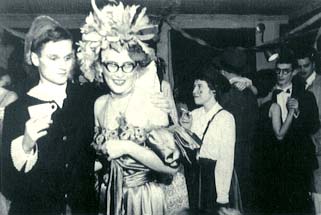
John Ashbery in party mode, with Nell Blaine |
|
A pretty good idea of the aesthetics of the New York School could be gleaned from such works as Koch’s “The Artist,” Ashbery’s “The Painter” and “Self-Portrait in a Convex Mirror,” and O’Hara’s “Memorial Day 1950” and “Why I Am Not a Painter,” all of which treat the visual arts as a kind of allegorical surrogate for poetry. |
|
It seems both just and inevitable that Ashbery, O’Hara, Koch, and Schuyler gave their first public readings at the Club, the nondescript Eighth Street loft where the Abstract Expressionists gathered weekly to hash out aesthetic issues.
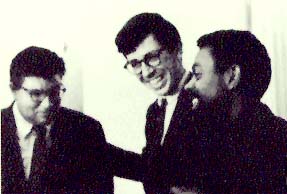
Detail: Morton Feldman, Kenneth Koch, Le Roi Jones |
|
Koch was the first to achieve a national reputation. His innovative techniques for teaching poetry
to schoolchildren — as described in Wishes, Lies, and Dreams (1970) and Rose, Where Did
You Get That Red? (1973) — made him the most famous poetry teacher in America. O’Hara’s
posthumous apotheosis came in 1972, when his Collected Poems won the National Book Award in
poetry. Ashbery, though a darling of the international avant-garde, was still a well-kept secret
until 1976, the year his Self-Portrait in a Convex Mirror was the dark horse that won the
Triple Crown — the Pulitzer Prize, the National Book Award, and the National Book Critics Circle
Prize. Overnight Ashbery became an inescapable presence in American poetry, provoking seminars,
debates, essays in criticism, a fair amount of attention in the national press, more prizes and
honors, a great many imitators, and a slew of never-say-die critics bent on denigrating their
favorite bête noir. Schuyler, the last of the four core members of the New York School to
come to prominence, did so when his Morning of the Poem won the Pulitzer in 1980, due in
part to the efforts of Ashbery, who was one of the judges that year.
|
|
“THE LAST AVANT-GARDE” aspires to
combine cultural history, biography, and literary analysis. In the first half of the book, I
profile Ashbery, O’Hara, Koch, and Schuyler singly and as a group. I mean to show that this
remarkable gang of four, though different from one another in ways that I will make clear, should
be considered in the light of what they shared. Contemporary critics tend to treat Ashbery as an
isolated case. Without wishing to diminish Ashbery’s great singularity, I believe that the
spirit of collaboration and the sense of common cause linking these poets are too important to be
minimized or ignored.
|

|
|
The poets of the
New York School were avant-garde at a time when that designation meant something. They are not the
last avant-garde movement we will ever have. But at the moment the conditions surrounding art and
literature are anything but favorable to the idea of an avant-garde. The problem has something to
do with the decline of the public intellectual and the corresponding expansion of the purview of
academe; the idea that something can be at once avant-garde and academic would seem a contradiction
in terms. Gertrude Stein summarized a second problem in “Composition as Explanation,” a
lecture she delivered at Oxford and Cambridge in 1926. “For a long time everybody refuses and
then almost without a pause almost everyone accepts,” Stein wrote. “In the history of the
refused in the arts and literature the rapidity of the change is always startling.”
|

Detail: Frank O’Hara, Larry Rivers, and Grace Hartigan at the Five Spot, 1957, photo copyright © Burt Glinn, 1957
|
|
I consider the death of O’Hara to signal the end of the first phase of the
New York School as an avant-garde movement. It is possible, even probable, that the three surviving
poets did their best work after O’Hara’s untimely demise. Still, I would argue, it was the
work the poets produced between 1948 and 1966 — when the spirit of collaboration and friendly
competition was at its most intense — that made their individual breakthroughs possible. In
concentrating on Ashbery, Koch, O’Hara, and Schuyler, I know I must necessarily stint other
admirable writers in their circle, such as Edwin Denby, Kenward Elmslie, Barbara Guest, and Harry
Mathews. It is no slur on these writers to observe that they do not seem nearly as central to the
New York School in the 1950s as the quartet I have chosen to emphasize. This was the
“secret” conviction of the poets themselves. In 1959, when they were planning the
magazine they came to call Locus Solus, James Schuyler wrote to John Ashbery,
“Secretly, I don’t think K. [Koch] believes anybody except you, he, Frank & me has
anything to offer.” Schuyler added, “While I am of this opinion too, of course, it seems
rather limiting for a magazine.”
|

|
|
It is no secret
that our own times are inimical to the imagination. Technology has put art to the rout. The concept
of fame has been degraded, replaced by the notion of celebrity, and poetry is recognized as an
expedient and sometimes eloquent way to hasten the aims of social justice on the one hand and of
marketing strategies on the other. Poetry consists of irreproachable sentiment rendered in
bite-sized pieces, doggerel for an inaugural. Or it is a rhymed injunction to the jury, or a rock
singer’s wail. Or perhaps it is something in the air of a hip, dark underground café that can
help sell blue jeans. How precious at such a time is true poetry, which resists the blandishments
of the celebrity culture, is impatient with pretense and piety, and remembers that the
gratuitousness of a work of art is its grace. If reality is indistinguishable from the consumerism
and mass thinking that the mass media foster, there is an urgent need for a poetry that can press
back against the pressures of reality, and I would argue that the example of the New York School
may best show the way.
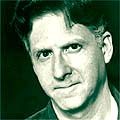
DAVID LEHMAN, author of Signs of the Times: Deconstruction and the Fall of Paul de Man and several books of poetry, is the series editor of The Best American Poetry. |
|
His essays, poems, and reviews have appeared in The New
Yorker, Paris Review, The Times Literary Supplement, and many other publications.
He is the recipient of many prizes and fellowships, including a Guggenheim and the Award in
Literature from the American Academy and Institute of Arts and Letters. He lives in New York City.
(photo of David Lehman copyright © Star Black, 1998)
david lehman |
|
This material is copyright © David Lehman and Jacket magazine 2001 |